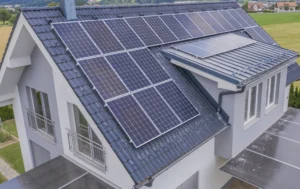A Complete Walkthrough of the Roof Replacement Process
Installing a new roof is a major investment and a significant step in improving your home’s durability, aesthetics, and value. A professionally installed roof not only protects your home but also enhances its curb appeal. If you’re considering a new roof installation, this step-by-step guide will take you through the entire process, helping you understand what to expect at each stage.
Step 1: Initial Consultation and Project Assessment
The journey to a new roof begins with an initial consultation, where a roofing expert will assess your requirements, discuss your budget, and outline expectations. This consultation allows the contractor to tailor the project to your specific needs and vision, whether you’re focused on budget or particular materials. This is a great time to ask any questions, like what to expect when getting a new roof quote or to gain insights into project timelines.
Step 2: Roof Inspection and Measurements
Next, a thorough roof inspection will be conducted to check for any damage, assess structural integrity, and accurately measure dimensions. This inspection is vital to understanding potential repairs or reinforcements needed, which can influence your roof replacement costs. Accurate measurements ensure materials are ordered precisely, minimising waste and helping keep your project on budget.
Step 3: Choosing Roofing Materials and Design
The choice of roofing material and design is a critical step in any new roofing project, as it impacts durability, style, and functionality. Here’s a look at some popular roofing options:
- Tiled Roofs: Known for durability and timeless appeal, tiled roofs – whether clay or concrete – are ideal for those seeking a long-lasting roof.
- Flat Roofs: Perfect for modern designs, flat roofs are often used for green spaces or added living areas. Materials like EPDM and TPO offer reliable waterproofing, so be sure to choose the right roof installers for your project to ensure quality.
- Slate Roofs: For a sophisticated look, slate is highly durable, often lasting over a century with proper care.
- Gable Roofs: Efficient in shedding rain and snow, gable roofs also provide attic space and better ventilation.
- Hip Roofs: These roofs slope on all sides, offering stability and weather resistance, ideal for areas with high winds.
Each material has its benefits, so consult with your contractor to choose the best roofing material for your climate, budget, and style.
Step 4: Preparing the Roof Site
Before the installation, the team will prepare the area around your home to ensure minimal disruption. Protecting landscaping, setting up scaffolding, and laying tarps all help keep the workspace tidy and safeguard your property. A clean, organised site is essential for a seamless roofing project.
Step 5: Removing the Old Roof
In most cases, replacing a roof involves tearing off the old materials. This removal process is thorough, with debris carefully handled and disposed of to maintain a clean work area. Proper disposal of old roofing material helps prepare a fresh, stable surface for your new roof installation, setting the stage for a durable result.
Step 6: Inspecting and Repairing the Roof Deck
With the old roof removed, the underlying roof deck—the structural base—is inspected. This step is crucial, as any weak spots or signs of rot must be repaired before the new roof is installed. A solid deck ensures your roof will be stable and secure, supporting the longevity of your roof investment.
Step 7: Installing Roof Underlayment and Flashing
To create a strong barrier against water, your contractor will first install underlayment over the roof deck. Flashing, a protective sealant around vulnerable areas like chimneys and vents, is also added at this stage. Together, these elements help to prevent water damage, safeguarding your new roof and the integrity of your home.
Step 8: Laying the Roofing Material
With the foundation in place, it’s time to install the primary roofing material, whether shingles, tiles, metal, or slate. Each material requires a specific installation technique to ensure durability and appearance. Experienced contractors will carefully align and secure each piece, providing a seamless, weather-resistant finish for your new roof.
Step 9: Adding Ridge Caps, Ventilation, and Final Details
After the main roofing material is installed, ridge caps are carefully added along the roof’s highest points. These are followed by ventilation elements designed to regulate attic temperature and moisture effectively. Together, these finishing touches not only improve the overall performance of your roof but also enhance your home’s energy efficiency. Ensuring a professional touch during this stage guarantees that your roof remains both functional and visually appealing for years to come.
Step 10: Final Inspection and Quality Assurance
Once the installation is complete, a final inspection is conducted to ensure that everything meets strict quality and safety standards. During this review, the team checks for any issues with alignment, proper sealing, and overall workmanship. This thorough quality assurance process is crucial for confirming that your roofing project has been completed to the highest standard. As a result, you can have peace of mind knowing your new roof is durable, secure, and built to perform reliably.
Step 11: Clean-up and Post-Installation Care Tips
After the final inspection, the team will thoroughly clean up the worksite by removing any debris, thereby leaving your property in pristine condition. Additionally, your contractor might provide valuable tips on post-installation care. For instance, they may recommend regularly cleaning your gutters or inspecting the roof following severe weather conditions. By following this advice, you can effectively maintain your roof, prolong its lifespan, and maximise the return on your investment.
The Summary: A New Roof Installation
A new roof installation is a complex process; however, each step is essential to achieving a durable, high-quality result. By partnering with experienced professionals, you can ensure that each phase is handled with care and precision. From the initial consultation to the final inspection, every stage plays a vital role in delivering a successful roofing project.
If you’re ready to start your roofing journey, contact All Custom Roofing for a detailed estimate and expert advice tailored to your needs. With the right team, you can look forward to a smooth, efficient, and stress-free experience.



